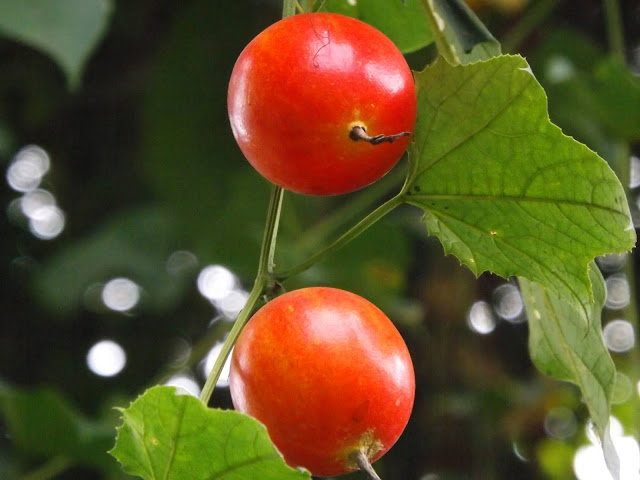Makal or Mahakal, Trichosanthes tricuspidata
Makal or Mahakal (Trichosanthes tricuspidata, family: Cucurbitaceae) is a woody climber with tendril and branches, attaining a height of 10-12 m. The multiangular-branched plant climbs up very far by holding any tree in the forest. It is found in the hilly areas as well as plain forests and village thickets in Bangladesh. It is also found in Indian subcontinent, Australia and some countries of South and Southeast Asia.
According to ancient Sanskrit scriptures the other names of the plant are Bishala, Mohendro-baruni.
In the Himalayas it has been seen at an altitude of 5000 feet. There are many refferences to the fruit in Bangla and Sanskrit literature. Someone is very nice to look at but he/she is useless--writers usually jokingly give examples of this fruit. Its roots and attractive fruits are packed with medicinal properties.
The size and shape of leaves may vary. These are multilobed or trilobed, alternate, rough in both sides, 5-12 cm long, petioled, cordate at base, deeply dented.
Its flowers have a great resemblance to Chichinga or Snake gourd flowers. Flowers are exceptional, in a word wonderful. These are unisexual, growing from the axil of leaves, funnel-shaped, having long tube, 5-7 cm long. Petals 5 with crown-like appendix. Like many other white flowers it blooms at night. Flowering occurs in the rainy season.
Many-seeded fruit is almost round or oval-shaped, brilliant red in color, 5 cm in diameter. Seeds are thin, smooth and grey. Although it looks eye-catching, it is inedible to human. In fact, it is a poisonous fruit. But it is a favorite food of birds. The fruits ripen in Aug-Sept. Propagation of the plant is caused by seeds.
Fruits play a very beneficial role in asthma. These are also used in nose and ear wounds. Roots are used in boil. Seeds are used in laxative.






Seth makal price ?
ReplyDeleteArr dhutrar jura guta lagai price please ?....
Shet makal price nd how to buy
ReplyDeleteJust amazing photography..
ReplyDeleteHello
DeleteHi!
Deleteবেশ ভালো হয়েছে
ReplyDeleteGhhh
Deleteফল টা কি সুন্দর !
ReplyDeleteবাহ !
ReplyDeleteএই প্রথম মাকাল ফল দেখলাম
ReplyDeleteIn my opinion, C-liquid vape is the best vaping product on the market. When contrasted with competing products, its smooth and gratifying hit is hard to beat. Additionally, every session is delightful because to its various flavors. C Liquid is consistent and of high quality, so it's worth a try whether you're a beginner or an expert vaper.
ReplyDeleteBeautiful fruit/|\
ReplyDeleteAE3ED98860
ReplyDeleteGörüntülü Sex
Görüntülü Show
Görüntülü Şov